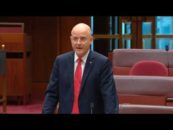by David Leyonhjelm
When I proposed that childcare subsidies be reduced where household income exceeds $250,000, and eliminated where it exceeds $350,000, the major parties wet their pants.
I had the government over a barrel so it said nothing, but Labor and the Greens went into conniptions. Labor claimed it “undermines the universal nature of access to early education”. Senator Hanson-Young of the Greens went further, saying, “As a mother who has relied my entire parenthood on paid childcare in order to be able to do my job, as many other working mothers around this country do, I find it galling to be told by a middle‑aged bloke in this place that it is not a legitimate service to offer support for working mums in terms of paying for childcare. It is pathetic.”
Thankfully Labor and the Greens gave up the fight over the $350,000 cut-off so it is now law. But all three voted to retain the subsidies for those earning up to that amount.
The next big debate in the Senate will be on government support for school education. Even if the Senate only shows equivalent resolve, taxpayers might save more money.
Under the Gonski formula, Commonwealth funding of non-government schools takes into account the “capacity to contribute” of the parents whose children go to those schools. The benchmark is the Schooling Resource Standard for government schools. Non-government schools receive 10 per cent less than this standard if their parents have incomes that are well below average, 12 per cent less if they have average incomes, and up to 80 per cent less if the parents are assessed to have above‑average incomes.
Three big problems
There are three big problems with this. First, if parents with children at a particular school have incomes that are well below average, there is no case for cutting funding. Fairly obviously, such parents have negligible capacity to contribute.
Second, the government’s assessment of parental capacity to contribute is shoddy. All it does is collect the addresses of parents whose children go to a particular school and uses these to rate the school. If those addresses tend to be in poor suburbs, the government assumes that all the parents of the school have a limited capacity to contribute, while if they are in rich suburbs, it assumes they have a significant capacity to contribute.
This discriminates against poor parents who live in rich suburbs, who may need to be close to their jobs, and favours rich parents who live in the best spots of poorer suburbs or towns.
Third, the government’s capacity-to-contribute policy does not apply to government schools. If it did, funding for government schools where the parents earn well above average incomes would be reduced, even if the reduction did not approach the 80 per cent reduction imposed on non‑government schools.
There are thousands of extremely well off parents who send their children to government schools. While that’s fine, it is not fine that these parents receive the same taxpayer-funded support as poor parents who send their children to government schools, and more support than poor parents who send their children to non-government schools, such as in the Catholic sector.
Preferred alternative
My preferred alternative would see individual parents directly receive school vouchers based on their personal income and any special needs of their children. Schools would be funded via the vouchers of the children who attended, with the state and federal governments sharing the voucher cost.
While this might be a bit too brave for the current government, there is still plenty of room to improve its new funding proposal. For example, rather than ask parents for addresses, the government could just ask parents for their tax file numbers and have the ATO work out their average income, with school funding based on their genuine capacity-to-contribute.
Government schools could do the same, and require contributions from parents with above average incomes. The ATO could assist, and recoup any outstanding contributions come tax time.
The Senate saw the light in the childcare debate, at least to some extent. Subsidies and welfare should not be going to those who do not need it. It’s time this logic was applied to the subsequent years of a child’s education. School education is vital, which is why we make it compulsory, but when parents earning more than $350,000 send their children to school, we don’t need to subsidise them.
David Leyonhjelm is a Senator for the Liberal Democrats
First published in the Australian Financial Review









